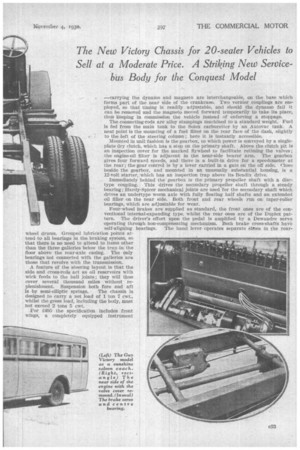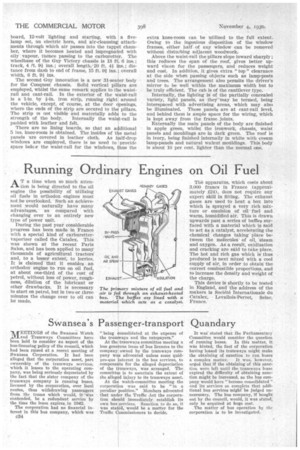Innovations in
Page 62

Page 63

Page 64

If you've noticed an error in this article please click here to report it so we can fix it.
GUY PASSENGER MODELS
The New Victory Chassis for 20-seater Vehicles to Sell at a Moderate Price. A Striking New Service bus Body for the Conquest Model
VISITORS to the Scottish Show will have the opportunity for examining two new Guy machines which are certain to interest those connected with the passenger-carrying industry. One is tile Victory chassis, jua introduced, the other is a remarkable 31-seater body designed for servicebus duty when mounted upon the Conquest chassis.
The Victory is in a nutshell, a speedy six-cylinder model for 20-seater vehicles; in chassis form it costs £495. It is sold by Guy Motors, Ltd., Wolverhampton, also complete with standard forms of body. The one-man operated bus costs £790, whilst the de luxe sunshine saloon coach is priced at 1890. The all-weather coach is listed at £845.
All these vehicles have floating dashes, and the accessory equipment includes a fire extinguisher, mirror, destination box (with eight place names), belland-ticket box, and the finish is in blue, green, or brown, as desired. Although the Victory is only just made available to the public, the model has been undergoing service tests for the past year, and the design embodies no experimental components or assemblies.
So far as the frame is concerned, the main members are parallel behind the dash, the upswept portions over the rear axle being very shallow ; this eases the bodybuilder's task in no small measure. Between the dash and the rear-axle line the frame height is 2 ft. laden. In addition to the lateral bracing afforded by the rear mounting points of me engine, coupled by the crankcase, there are pressed-steel cross-members at the rear-spring anchorage points and several tubular ones. No rivets are employed in this frame, the maximum depth of which is 7 ins.
On the off side of the frame the tank is carried below four horizontal bearers; it is removable in a downward direction. Immediately below the filler cap is a quantity gauge. Below the frame overhang is the cradle for the spar a wheel, which is shod with a 32-in. by 6-in. tyre—this size holds good for all wheels—a point worth mentioning.
The engine is of 3,620 c.c., and is rated at 24 h,p. The six cylinders are of 80 mm. bore and 120 mm. stroke, The valves are mounted overhead, and are carried in a detachable cylinder head. The camshaft runs in seven bearings in the crankcase, and the valve-opening effort is transmitted from it to the rockers by push rods; the overhead mechanism for the valves is enclosed in an oil-tight aluminium cover.
Seven bearings are also used for the crankshaft which is lubricated on the pressure system by a submerged gear pump. This system also attends to the camshaft and accessory drives, whilst there is a feed to the valve gear and timing wheels. A. maintenance point of note is that the brackets- wheel drums. Grouped lubri6ition points attend to all bearings in the braking system, so that there is no need to .attend to items other than the three galleries below the trap in the floor above the rear-axle casing. The only bearings not connected with the galleries aro those that revolve with the transmission.
A feature of the steering layout is that the side and cross-rods act as oil reservoirs with wick feeds to the ball joints ; they will thus cover several thousand miles without replenishment. Suspension both fore and aft
is by semi-elliptic springs. The chassis is designed to carry a net load of I ton 7 ewt:, whilst the gross load, including the body, must not exceed 2 tons 5 cwt.
or E495 the specification includes front wings, a completely equipped instrument —carrying the dynamo and magneto are interchangeable, on the base which forms part of the near side of the crankcase. Two vernier couplings are employed, so that timing is readily adjustable, and should the dynamo fail it can be removed and the magneto moved forward temporarily to take its place, thus keeping in commission the vehicle instead of enforcing a stoppage.
The connecting-rods are alloy stampings machined to a standard weight. Fuel is fed from the main tank to the Solex carburetter by an Autovac tank. A neat point is the mounting of a fuel filter on the rear face of the dash, slightly to the left of the steering column ; here it is instantly accessible.
Mounted in unit fashion is the gearbox, to which power is conveyed by a singleplate dry clutch, which has a stop on the primary shaft. Above the clutch pit is an inspection cover for the marked flywheel to facilitate retiming the valves; the engine-oil filter is adjacent in the near-side bearer arm. The gearbox gives four forward speeds, and there is a built-in drive for a speedometer at the rear ; the gear control is by a lever carried in a gate on the off side. Close beside the gearbox, and mounted in an unusually substantial housing, is a 12-volt starter, which has an inspection trap above itsBendix drive.
Immediately behind the gearbox is the primary Propeller shaft with a disctype coupling. This drives the secondary propeller shaft through a steady bearing; Hardy-Spicer mechanical joints are used 'for the secondary shaft which drives an undertype worm axle with fully floating half shafts and an extended oil filler on the near side. Both front and rear wheels run on taper-roller bearings, Which are adjustable for wear.
Four-wheel brakes are supplied as standard, the front ones are of the conventional'internal-expanding type, whilst the rear ones are of the Duplex pattern. The driver's effort upon the pedal is amplified by a Dewandre servo operating through non-compensating mechanism. Both brake cross-shafts have self-aligning bearings. The hand /ever operates separate shbes in the rear
board, 12-volt lighting and starting. with a fivelamp set, an electric horn, and air-cleansing attachments through which air passes into the tapplA chamber, where it becomes heated and impregnaed with oily . vapour, thence passing to the carburetter. The wheelbase of the Guy Victory chassis is 13 ft. 6 ins.; track, 4 ft. 9i ins.; overall length,20 ft. 41 ins.; distance from dash to end of frame, 15 ft. 91 ins.; overall width, 6 ft. In ins.
The second Guy innovation is a new 3I-seater body for the Conquest chassis. Solid vertical pillars are employed, whilst the same remark applies to the waistrail and cant-rail. In the exterior of the waist-rail is a 1-in. by Fin, iron strip, running right around the vehicle, except, of course, at the door openings, where the ends of the strip are secured to the pillars. The strip is not visible and materially adds to the strength of the body. Internally the waist-rail is padded with leather and felt.
There are no lining boards, so that an a ditional 5 ins, knee-room is obtained. The insides of t e metal panels are covered in leather cloth. As alf-drop windows are employed, there is no need to provide space belo the waist-rail for the windows, thus the extra knee-room can be utilized to the full extent. Owing to the ingenious disposition of the window frames, either half of any window can be removed without disturbing adjacent woodwork.
Above the waist-rail the pillars slope inward sharply ; this reduces the span of the roof, gives better upward vis:on for the passengers, and reduces weight and cost. In addition, it gives extra " top " clearance at the side when passing objects such as lamp-posts and trees. The arrangement also permits the driver's mirror to be well within the maximum width but to be truly efficient. The cab is of the cantilever type.
Internally, the lighting is of the partially concealed variety, light panels, as they may be termed, being interspaced with advertising areas, which may also be illuminated. These panels are at cant-rail level, and behind them is ample space for the wiring, which is kept away from the frame joints.
Externally the main panels of the body are finished in apple green, whilst the ironwork, chassis, waist panels and mouldings are in dark green. The roof is in ivory, being finished internally in white with cream lamp-panels and natural walnut mouldings. This body is about 10 per cent. lighter than the normal one.




























































































































